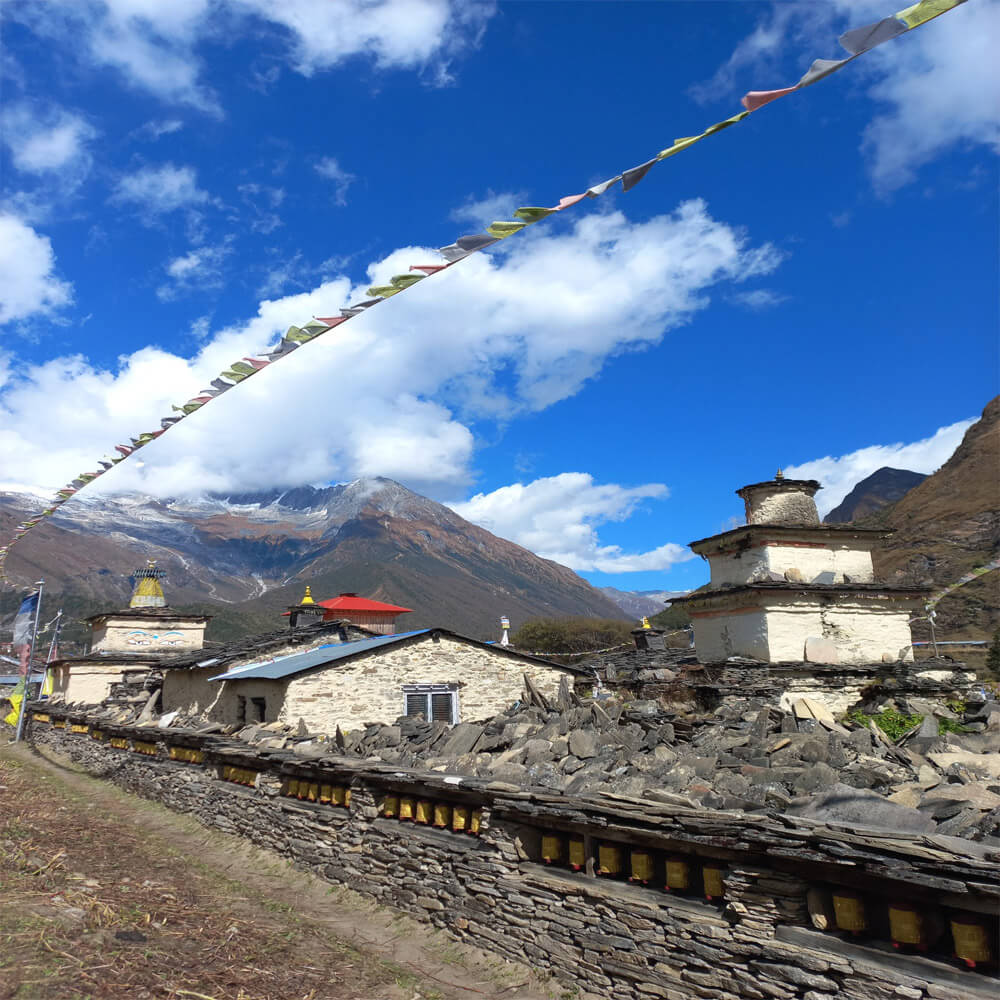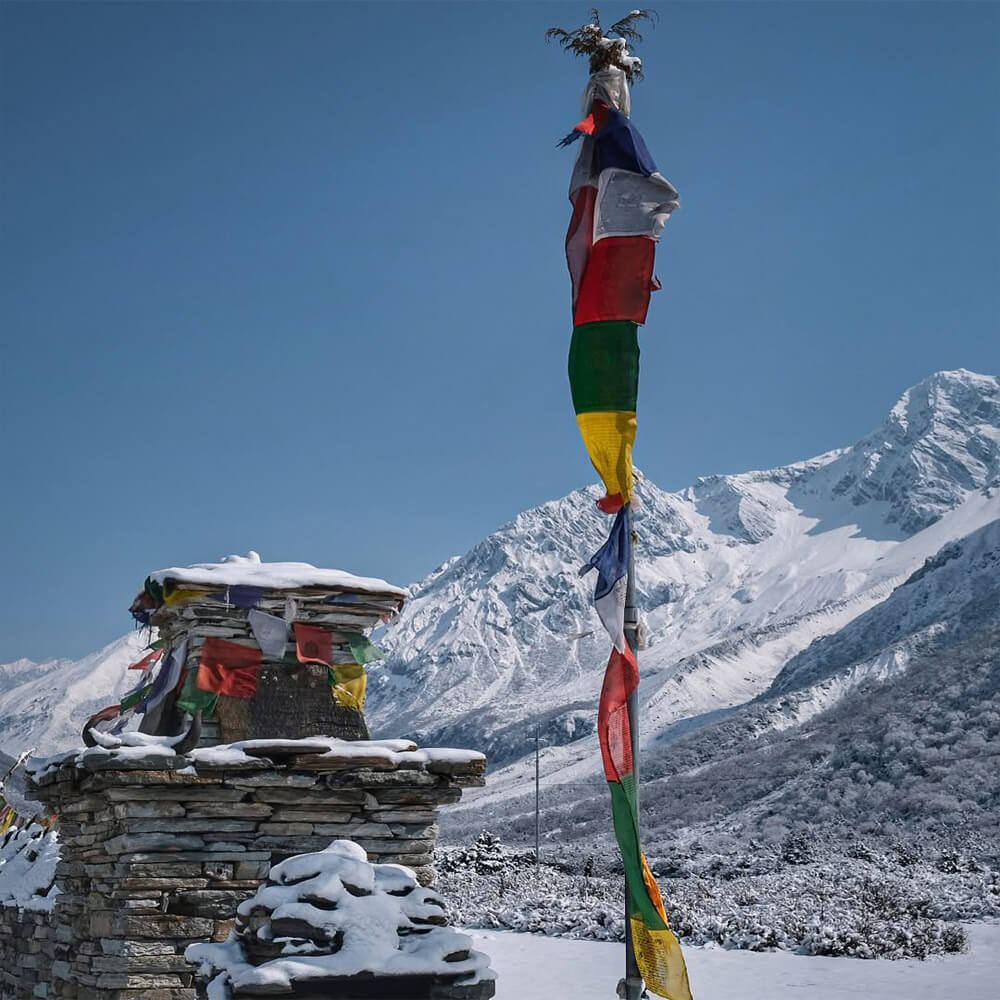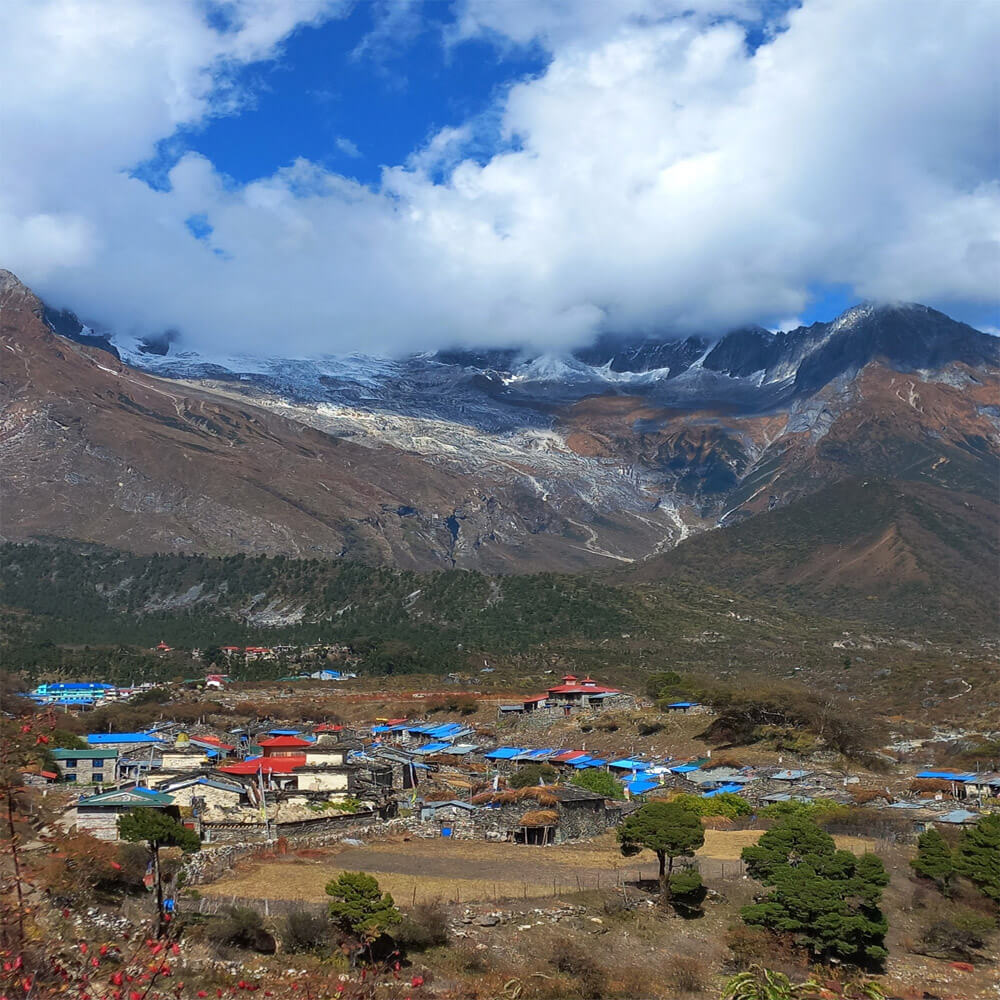Tsum Valley trek difficulty is considered moderate, but it requires good physical fitness and preparation. The trail leads into a secluded and less-visited region of Nepal, where the terrain can be rugged, steep, and occasionally slippery. Trekkers frequently trek for six to seven hours every day, which can be exhausting, and they frequently travel uphill and downhill. In contrast to well-known treks like Everest Trekking or Annapurna Trekking, the valley's infrastructure, food options, and tea houses are more modest because it is located in a restricted area. Trekkers must therefore become used to modest lodging and little luxury.
Altitude is another element that makes things more difficult. The ascent progressively rises over 3,000 meters, with the highest peaks surpassing 4,000 meters. Appropriate acclimatization and pacing are crucial because some trekkers may experience moderate symptoms of altitude sickness at this level. Preparation and self-awareness are crucial because of the remote location, which also implies fewer rescue facilities and limited access to medical assistance. The trek rewards you with serene scenery, Buddhist culture, and breathtaking Himalayan views, despite the difficulties. This blog will provide a detailed explanation of the difficulty level of Tsum Valley trek so you can confidently plan and get ready.
Overall Difficulty Level of Tsum Valley Trek

The difficulty level of Tsum Valley trek is considered moderate to challenging. The Tsum Valley is less developed and more distant than otherpopular treks in Nepal. As a result, trekkers must contend with higher elevations, lengthy walking days, and inadequate infrastructure. You will typically walk six to eight hours per day, frequently on difficult and rocky paths. As the trek progressively ascends above 3,500 meters, altitude acclimation becomes crucial. The route is more difficult because of its remote location even if it is not as steep as some of Nepal's most difficult treks. To appreciate this expedition, trekkers need to be mentally prepared, have some basic trekking experience, and have decent stamina.
Physical Demands and Altitude
One of the major Tsum Valley trek challenges is altitude. The trail passes over 3,000 meters in many places, and the thinner air on some days can make it feel exhausting. Trekkers should take their time, acclimate, and drink plenty of fluids because altitude sickness is a serious risk. The trek calls for endurance and strong legs. Sometimes the pathways are steep, rocky, and narrow. For novices, walking for several days in a succession, carrying a daypack, and enduring cold nights might be challenging, but doable with planning.
Remote Terrain and Limited Facilities
In contrast to well-known climbs like Everest or Annapurna, the Tsum Valley is less developed. There are simple homestays and teahouses, but the amenities for communication, food, and accommodation are relatively basic. Rare are diversified meals and hot showers. The walk is more genuine because of its rustic charm, but it becomes more challenging in terms of comfort. Trekkers need to be psychologically ready for basic living and erratic weather.
The difficulty level of Tsum Valley trek is due to both its physical demands and its remote location. Trekkers can experience calm, culture, and unspoiled Himalayan beauty by embracing the challenges as a part of the journey with the right mindset, gradual pace, and fitness training.
Altitude-Related Challenges in the Tsum Valley Trek
The Tsum Valley is a little-known treasure in the Himalayas, but trekking there has its own set of difficulties, mostly related to elevation. This trip gradually moves you into higher territory with lower oxygen levels than Nepal's lower-elevation climbs. Let us examine how altitude affects this journey and what preparations trekkers might make.
Tsum Valley Altitude Difficulty
The Tsum Valley altitude difficulty becomes noticeable as trekkers go beyond 3,000 meters. The route gradually ascends through alpine woods, historic monasteries, and isolated communities until it reaches above 3,700 meters close to Mu Gompa, but most routes begin in low-lying villages. Because oxygen levels are lower at this elevation, many people experience weariness, mild headaches, or shortness of breath. Although it is not as challenging as extremely high treks like Everest Base Camp, it nevertheless calls for vigilance and appropriate pace. The altitude can surprise unprepared trekkers, however beginners tend to underestimate this part, believing that the valley's concealed nature makes it easier.
Tsum Valley Trek Altitude Sickness
One of the main risks here is Tsum Valley trek altitude sickness. When the body is unable to adjust to the thin air, it might result in Acute Mountain Sickness (AMS). Nausea, lightheadedness, insomnia, and appetite loss are some of the symptoms. Because there are not many medical services in the isolated valley, prevention is more crucial than cure. Trekkers should never disregard early warning signs because doing so can make the situation worse. Simple yet efficient strategies to lower the risk include eating a healthy diet, walking steadily, and drinking lots of water.
Tsum Valley Trek Acclimatization
Tsum Valley trek acclimatization is a crucial step in overcoming difficulties brought on by elevation. After arriving at higher communities, such as Chhokangparo, trekkers typically take a day off or acclimation. The body can gradually acclimate during this respite before continuing to climb. Experienced trekkers also employ the strategy of climbing high during the day and sleeping at a little lower altitude. To make the trip safer and more pleasurable, reputable trekking companies incorporate acclimatization days into their itineraries. The trek becomes considerably hazardous without acclimatization, particularly for people who are not accustomed to high elevations.
Altitude still has a significant impact on the overall difficulty of theTsum Valley trek, even though it is not as high as some other Himalayan expeditions. Careful acclimation and a gentle ascent typically keep trekkers safe. The path is less stressful and far more gratifying when one is ready and aware of the hazards.
Terrain and Trail Conditions
Tsum Valley Trek Terrain

The Tsum Valley trekking terrain is varied and keeps changing as you move deeper into the valley. The trek starts off with steep stone steps, winding walkways, and hanging bridges as it follows the Budhi Gandaki River. The landscape changes to alpine meadows, pine trees, and steep pathways as you ascend higher. Trekkers must traverse cliffside routes with precipitous drops in certain places, which makes the journey both exhilarating and difficult. This makes it more difficult because the paths are not as well-maintained as those on well-known routes like Annapurna or Everest.
Tsum Valley Trek Route Conditions
The Tsum Valley trekking routes conditions depend largely on the season. Trails are still rough and uneven in the fall and spring, but they are comparatively dry and easier to traverse. Landslides and slippery mud can make progress hazardous and slow during the rain. The highest routes are covered with snow and ice in the winter, which can make it difficult to cross steep areas or block passes. Trekkers must rely more on local knowledge and guides because there are less amenities, such as signboards or wide walking trails, than in other trekking destinations.
Remote Trekking in Nepal Difficulty
The Tsum Valley is a great example ofremote trekking difficulty in Nepal. Because of its isolated location, there are fewer tea houses, it takes longer to walk between settlements, and there are less rescue services available in an emergency. Trekkers should expect to live simply, eat simply, and be without contemporary conveniences. It is crucial to have extra supplies, warm clothing, and appropriate footwear on hand. Although the physical challenge is moderate to challenging, the solitude and lack of infrastructure present the biggest obstacles. This makes it ideal for trekkers who are prepared to face difficulties and seek a genuine Himalayan experience.
Physical Fitness Requirements
Building Physical Fitness for Tsum Valley Trek
When planning for the Tsum Valley adventure, one of the first things to consider is physical fitness for Tsum Valley trek. The trek is lengthy and requires walking nonstop for several days. Trekkers may walk for six to eight hours on some days, which calls for strong legs and general stamina. Even while technical climbing skills are not necessary for the trek, it is nonetheless advisable to prepare your body with running, stair climbing, and mild muscle training. These exercises increase flexibility, strength, and balance, which makes trekking in Nepal easier and less taxing.
Understanding Tsum Valley Trek Stamina Requirements
The Tsum Valley trekking stamina requirements are moderate to high compared to shorter trails. Because the trek frequently reaches elevations above 3,500 meters, endurance is essential for acclimating to thinner air. Trekkers should begin training two to three months in advance, progressively increasing the length and distance of their walks. The body becomes accustomed to bearing weight on uneven terrain by practicing extended excursions with a backpack. Increasing cardiovascular endurance by swimming or cycling might also help you stay energized during the lengthy trekking days.
Practical Tips for Tsum Valley Trek
Anyone interested in trekking in Nepal should remember that fitness is not only about strength but also about pacing. Taking it leisurely, drinking enough of water, and taking breaks when necessary can all help to make the trip more pleasurable. To prevent muscle strain throughout the walk, it is also a good idea to incorporate flexibility exercises like yoga or stretching into your routine. Equally crucial is mental preparation; being aware that you may encounter difficult paths and long walking distances keeps you optimistic. Trekkers of all ages can successfully complete the Tsum Valley trip and thoroughly appreciate the culture and beauty of this undiscovered Himalayan region if they prepare properly.
Technical Challenges of the Tsum Valley Trek
Although the Tsum Valley Trek provides a unique Himalayan experience, trekkers can expect a number of technical difficulties. Being aware of these difficulties promotes safety, appropriate pacing, and a fulfilling journey.
Steep Ascents and Descents
Handling the steep ascents and descents is one of the main technical obstacles on the Tsum Valley trek. Many of the trail's portions require climbing up rocky slopes or descending into river valleys, even if the valley itself has some calm stretches. Strong leg muscles, good endurance, and cautious attention to footing are necessary for these parts, particularly in ice or rainy conditions. Because quick ascents might raise the risk of altitude sickness, trekkers should also be aware of altitude gain. They can better control their weariness and sustain their energy levels for the long days on the route by pacing themselves and taking frequent breaks.
Narrow Trails and River Crossings
Navigating tight, occasionally uneven trails is another hard component of the Tsum Valley trek. Some sections go along steep slopes or cliff edges, where balance and cautious walking are crucial. Trekkers also need to be mindful of the stability and flow of bridges because river crossings are common, particularly after rain or snowmelt. These challenges are intensified by the Tsum Valley trek daily walking hours, which typically range from 5–8 hours per day. Long daily walks on difficult terrain need concentration and endurance, thus it is critical to wear suitable, traction-enhancing footwear and carry only the bare necessities.
At higher elevations, frozen spots, loose gravel, and sporadic landslides are additional factors. Due to these circumstances, trekkers must remain vigilant, heed the advice of their guides, and modify their pace in accordance with the route conditions.
All things considered, the Tsum Valley Trek is relatively challenging due to its technical difficulties, even though it is not a climbing excursion. Proper preparation, awareness of trail conditions, and careful attention to Tsum Valley Hiking walking hours allow trekkers to navigate these challenges safely, making the journey both rewarding and memorable.
Cultural and Environmental Factors
The Tsum Valley trekking experience level is shaped not just by physical challenges but also by the unique cultural and environmental conditions of the region. Tsum Valley is a remote Himalayan region that has preserved its traditional Tibetan Buddhist culture for generations. It is located in the northern section of Gorkha province. Compared to well-known trekking routes like the Annapurna or Everest regions, trekkers must expect fewer amenities, less connectivity, and greater independence due to this isolation.
Remote Villages and Local Culture
Ancient monasteries, mani walls, and prayer flags abound in the Tsum Valley's small, traditional communities, including Chumling, Chhekampar, and Mu Gompa. Trekkers with the Tsum Valley trekking experience level of moderate to advanced will appreciate the chance to interact with locals, learn about Tibetan Buddhism, and witness traditional lifestyles largely untouched by modern tourism. Food selections may be modest, tea houses are simple, and electricity may be scarce. Trekkers can have a true Himalayan experience in this setting, which demands patience and adaptability but also provides a profoundly fulfilling cultural immersion.
Environmental and Terrain Considerations
The natural setting of Tsum Valley makes the trek much more challenging. High hills, glaciers, and river systems round the valley, forming rugged, winding paths and sporadic river crossings. Seasonal changes can have a significant impact on route conditions. For example, winter snow makes trails more difficult to access and can create landslides. Trekkers with a suitable Tsum Valley trekking experience level should be prepared for unpredictable weather, and must carry proper gear such as trekking poles, layered clothing, and sturdy footwear. Preserving this beautiful ecosystem requires following designated routes, respecting the local ecology, and properly disposing of rubbish.
The cultural and environmental features, together with its isolated communities, sparse amenities, and untamed landscape, make it a journey best suited for people with moderate to high levels of fitness and previous trekking experience. The distinctive beauty, tranquility, and cultural diversity counterbalance these difficulties, making the trip over the Himalayas very remarkable.
Tips to Manage Tsum Valley Trek Difficulty
Hire Experienced Guides and Porters

Hiring knowledgeable guides and porters is one of the best ways to handle the difficulty of Tsum Valley Trek. Guides ensure you follow the right acclimatization procedures, offer local information, and assist you in navigating challenging areas. Porters are capable of carrying bulky loads, saving you energy for strenuous treks and ascents. Using local resources improves your cultural experience and boosts the local economy.
Pace Yourself and Acclimatize Properly
For trekking at high altitudes, a gradual pace is crucial. Plan acclimatization days at strategic locations like Chumling or Mu La Pass rather than cramming yourself with lengthy walking days. In addition to increasing energy levels and lowering the chance of altitude sickness, proper acclimatization also makes steep ascents easier to handle. Keep in mind that getting there safely is more important than getting there fast.
Prepare with Physical Training
Do aerobic activities, backpack trekking, and leg and core strength training before to the trek. Being physically healthy will make it easier for you to manage long daily distances, rugged paths, and steep ascents.
Pack the Right Gear
Wearing excellent trekking shoes with good traction, carrying trekking poles, and having layered gear for various weather situations will make the journey safer and more comfortable. Sun protection, a first-aid kit, and water bottles are essential necessities.
Eat Healthily and Drink Plenty of Water
It is important to stay hydrated and energetic. During trekking days, eat regular meals, stay hydrated, and pack snacks. Your body can better handle altitude, exhaustion, and extended walking distances if you eat well.
Choosing best time for Tsum Valley trek
Thebest time for Tsum Valley trek is during spring (March–May) and autumn (September–November). These seasons offer clear skies, stable weather, and comfortable temperatures, making trails safer and providing stunning mountain views, vibrant landscapes, and ideal conditions for photography and cultural experiences in the remote Himalayan region.
Trekkers can lessen the difficulty of Tsum Valley Trek while still safely and pleasantly taking in its breathtaking scenery, vibrant culture, and tranquil Himalayan setting by heeding these advice.
Frequently Asked Question
How hard is the Tsum Valley Trek?
The trek is moderate to challenging. While trails are generally well-marked, trekkers face high altitudes, steep ascents, and long walking days, particularly around Mu La Pass (5,125m).
Do I need prior trekking experience?
Yes, prior trekking experience is recommended. Although technically non-technical, the remote terrain, long daily treks, and altitude require endurance, stamina, and familiarity with Himalayan trekking conditions.
What level of fitness is required?
Moderate to high fitness is essential. Trekkers should be comfortable walking 6–8 hours daily, climbing steep trails, and carrying personal gear, while maintaining energy for acclimatization days.
What are the main challenges on the trail?
Steep ascents, narrow paths, rocky terrain, river crossings, and possible snow or landslides in certain seasons. Limited facilities and remote villages increase logistical difficulty.
How can I manage the difficulty safely?
Hire a reliable guide and porter, follow a gradual pace, allow acclimatization days, and carry proper gear. Agencies like Nepal Trekking Routes provide support, ensuring safety while enhancing the trekking experience.
Conclusion: Tsum Valley Trek Difficulty
Long trekking days, remote terrain, and high altitude make the Tsum Valley Trek moderate to difficult. Particularly near Mu La Pass (5,125 meters), trekkers face rocky terrain, steep ascents, and narrow paths that call for cautious acclimatization, endurance, and strong physical fitness. Although fairly skilled trekkers may handle the walk, being well-prepared is essential to having a safe and enjoyable experience.
Selecting our company, Nepal Trekking Routes, has a big impact. Porters assist in carrying big items, which lessens physical strain, and their knowledgeable guides offer invaluable assistance, guaranteeing safe navigation through challenging portions. In order to free up trekkers to concentrate on the trip, they also manage permits, local logistics, and cultural insights.
The Tsum Valley Trek may be a fulfilling journey with the correct support, proper acclimatization, and a leisurely pace. Even for those who are worried about the trek's difficulty, the mix of the Himalayan views, Tibetan culture, and natural beauty makes it worthwhile. We guarantee a memorable and safe trip.










